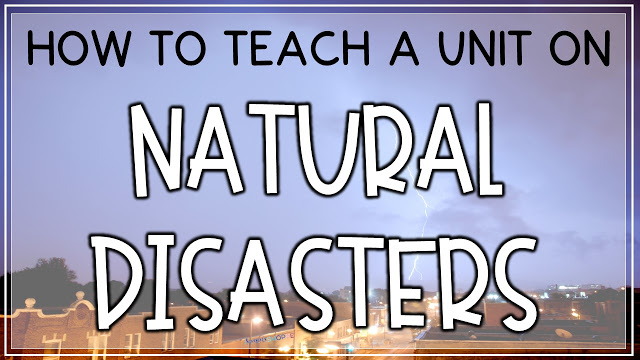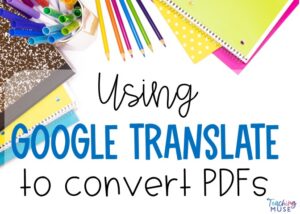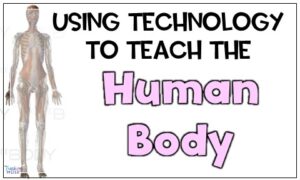Teaching a unit on natural disasters will instantly engage students. Most people find tsunamis, hurricanes, tornadoes, volcanoes, and earthquakes interesting, especially if they live in an area where they might come into contact with one. While you are teaching, a natural disaster unit is typically high in engagement, further student motivation while honing academic skills by using the following ideas.
Phenomena:
1. Vocabulary:
While there are various ways to teach natural disaster vocabulary, I like to start previewing vocabulary that students will encounter throughout the unit. This technique helps struggling students and ELL populations when they meet the terms in the text. Then, to further strengthen understanding, review terms again when the words are embedded in a text. During this time, have students use context clues to build upon their literacy skills.
Quizlet is a helpful free online tool that allows students to practice vocabulary terms independently through different activities.
2. Using WebQuests as a Natural Disaster Teaching Resource:
Students can gain background information about natural hazards through structured internet searches. By using student-friendly links, students will answer relevant questions to learn about natural disasters. The links can vary, allowing students to use
- video
- pictures
- short games
- quizzes
- written text
Natural disaster teaching resources like these help foster student independence in the classroom. Students can work together in pairs or small groups. If you have a hybrid classroom, you can pair a student in class with one at home by utilizing Google Breakout Rooms. You can also have different students answer one specific question and then review it together as a class in a jigsaw format to save time.
You can easily make your own by researching student-friendly websites and curate questions for each, or you can get ready to use ones here.
3. Videos:
Hook students through using videos. Whether it is a short video clip or a class period long movie, our students are learning and gaining information through videos, so this allows them to learn on their terms. Some videos will cover the vast majority of natural hazards, or I may choose to show one type of disaster that we are studying. Below are some examples of videos that I feel are student-friendly and cover this topic well.
- Science of Natural Disasters
- Why Do Buildings Fall in Earthquakes?
- Elephants Warn of Tsunami
- Yellowstone Supervolcano
- Brainpop: Includes both a video on ALL types of natural disasters or one specific type of hazard. Brainpop videos require an account. They include short videos that pair information about scientific concepts down to student understanding. In addition, the activities included will also allow students to further their knowledge and cement their understanding of natural hazards.
- Dr. Binocs Show: Again, these are short videos that give a bite-sized amount of knowledge on a topic. I like to use them to introduce or review a concept.
- Natural Geographic: NatGeo has an excellent compilation of both videos and photos of natural disasters.
Of course, you can also find news and video clips of actual natural disasters that occurred on Earth. Showing these real videos will engage students as they can see and understand how devastating they are. In addition, many students will develop empathy skills as they witness the horrors that are left behind from these extreme weather phenomenons.
4. Literacy in Science:
Reading and writing skills still need to be addressed in science class! Infuse literacy skills into your science curriculum by providing students with science texts that they will use to anchor their understanding and learn more about natural hazards. Text can come from your natural disaster teaching resources such as your science curriculum, sites like NEWSELA, or you may be interested in testing my activities out.
Throughout the natural disaster unit, tudents will learn what natural hazards are, how they form, where the disaster will most likely occur, and safety precautions. To remain flexible in today’s teaching environment, printable and digital options are available.
5. Reinforcement:
To further embed literacy skills and strengthen student knowledge of the topic, use graphic organizers with students. Graphic organizers can be used to:
- Summarize information about each natural disaster
- Compare and contrast natural hazards with one another
- Create a cause and effect chart to sequence how a natural disaster occurs or what a natural disaster will do to an area
6. Activities to Solidify Learning:
Hands on learning should be part of any science unit. Allowing students to design, test, and engineer in science will enable them to work on a different unique set of needed skills in the real world.
Hands on activities could include having students:
- Design and create a structure that can withstand strong winds during a hurricane
- Create a model of buildings that are tornado-resistant. Models can consist of posters with labels and explanations of how and why the buildings are strong enough to withstand wind damage from tornadoes.
- Test different materials that can withstand the impact of waves created from a tsunami.
- Students should determine what natural disasters can happen where they live and measures that should be taken to reduce the amount of damage to homes and businesses.









